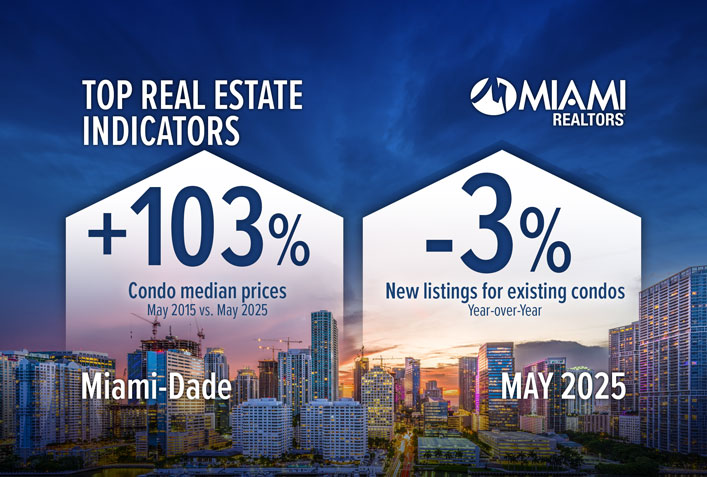Miami-Dade Condominium Market: 14 Years of Resilience and Growth
Overview of Market Trends
The Miami-Dade County condominium market is showcasing remarkable stability, with prices remaining steady or increasing for a remarkable 14 consecutive years. According to the latest data from the MIAMI Association of Realtors (MIAMI) and the Southeast Florida Multiple Listing Service (SEFMLS), this trend reflects the enduring appeal of Miami’s lifestyle both domestically and globally.
Key Insights from the Latest Data
- Price Appreciation: Miami condominium prices have surged 103.3% over the past decade, climbing from $209,000 in May 2015 to $425,000 in May 2025.
- Market Resiliency: Miami’s condominium market has shown consistent upward trends despite challenges from hurricanes, pandemics, and economic downturns. Eddie Blanco, 2025 MIAMI Chairman, highlighted that worldwide interest in Miami remains unabated, making condos an entry point for many first-time homebuyers.
Inventory and Listings
While inventory is on the rise, giving buyers more choices, Miami’s existing condominium listings remain 17% below pre-pandemic levels. Notably, new listings decreased by 3.4% year-over-year in May 2025.
Market Dynamics
- Existing Listings: A total of 18,879 active listings reported in May 2025 represent a 40.8% increase from the previous year, yet still fall 16.9% short of pre-pandemic numbers.
- Condominium Inventory: Even though new condominiums are being listed, the inventory is still below the pre-pandemic levels, with only 13,192 listings available.
The Single-Family Home Market
Miami-Dade single-family home median prices rose 3.85% year-over-year, climbing from $650,000 to $675,000. This marks the 162nd consecutive month of price increases, totaling a staggering 139.4% appreciation since May 2015.
Economic Impact
- The average economic impact of a single home sale in Florida is approximately $129,000, leading to a total local economic impact of $246 million in May 2025 due to 1,913 home sales.
Challenges in the Market
Multiple factors are currently influencing the real estate landscape:
- High Mortgage Rates: The average 30-year fixed mortgage rate hovers around 6.81%, contributing to lower sales numbers.
- Lack of FHA Financing: Only 21 out of 2,397 condominium buildings in the tri-county area are approved for FHA loans, limiting accessibility for many potential buyers.
Looking Ahead: New Construction Insights
MIAMI REALTORS® are preparing to unveil a new construction data report that will address the growing need for detailed statistics concerning new, pre-construction, and condominium conversion sales. This initiative aims to provide clearer insights into the South Florida new construction market, which is considered one of the strongest in the country.
Legislative Developments
The Live Local Act, passed in 2023, aims to promote affordable housing by allowing developers to build at higher densities if 40% of the units are designated as affordable for families at or below 120% of the area’s median income.
Cash Sales and Buyer Behavior
Cash transactions continue to dominate the market, representing 37% of total sales in May 2025, compared to the national average of around 27%. This trend highlights Miami’s attractiveness, especially for foreign buyers and those relocating from higher-cost markets.
Conclusion
In summary, the Miami-Dade condominium market continues to showcase balanced demand and resilience, making it a stronghold despite economic challenges. With favorable long-term trends and an increase in cash sales, the market remains appealing for both local and international buyers.
For more insights into the Miami real estate market, visit the MIAMI Association of REALTORS® for detailed reports and updates.
By focusing on the dynamics of the Miami-Dade condominium market and its implications, this article is designed to be informative and engaging while optimizing for search engines to attract interested readers.


